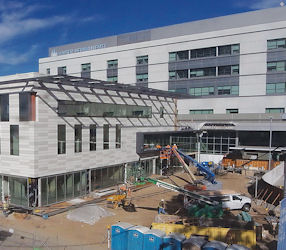While hospitals around the Valley consolidate and form partnerships amid the profound changes taking place in health care, another major system is going its own way. Managed care provider Kaiser Permanente has focused on construction as a way to expand its presence, with new or pending facilities in North Hollywood, Panorama City, Lancaster and possibly Santa Clarita. “With the building we have under construction, we think our physical assets will be in place for substantial growth for many years to come,” said Dennis Benton, Kaiser’s regional executive director. The Kaiser model depends on three separate but interlocking entities. The non-profit Kaiser Foundation Hospitals owns the system’s hospitals, including the 218-bed facility in Panorama City and the 175-bed Woodland Hills Medical Center. Kaiser Foundation Health Plan sells insurance to patients. The regional Permanente Medical Group employs doctors and contracts with the other entities to provide services. Kaiser Permanente is a trade name to market the consortium, which is based in Oakland. Financially, the construction is justified by sustained growth in Kaiser’s business. The east San Fernando Valley has about 240,000 members, the Western Valley and Conejo Valley have about 167,000, and the Santa Clarita Valley has 105,000. Benton said those numbers have grown by “several thousand” a year for a decade or more. Health reform wasn’t a direct cause of the construction boom, but Kaiser expects its membership will get a boost from the newly insured population. Barry Cohn, chief executive of insurance agency RGEB Employee Benefits in Woodland Hills, said that on the new Covered California individual exchange, Kaiser is among the higher-priced insurance policies. But he doesn’t expect its growth will slow down because between 15 and 20 percent of the people in the greater Valley love Kaiser. In particular, people who grew up under Kaiser and immigrants who find it similar to the medical system in their countries of origin are loyal clients. “Their growth has been pretty good, so building facilities adjacent to their current service areas is a good strategy,” Cohn said. “There is a segment of the population that likes the Kaiser model and will go with it even if it’s higher cost.” Construction projects Kaiser’s largest building site is a specialty doctor office in Lancaster. When completed it will total 136,000 square feet and will employ 66 doctors. Services at the center will include surgery, cancer specialists, pain management and infectious disease. It is scheduled to open by the end of 2014. In Panorama City, Kaiser is building a six-story 72,000-square-foot specialty building that will include diagnostic imaging labs, nuclear medicine, infusion (IV) therapy, speech therapy and a wound clinic. Construction is expected to finish in February, with a grand opening in April or May. In North Hollywood, Kaiser opened a 31,000-square-foot building in September. It currently has a staff of 10 doctors, but the space can accommodate 18 as the market grows. In addition to 31 exam rooms, the building has a laboratory, an x-ray room, a medical imaging lab and a pharmacy. The on-site doctors focus on primary care, gynecology and pediatrics. Also, Kaiser has purchased a building in Santa Clarita but is still figuring out how to convert it to medical offices. Benton said the intention is to bring more specialty services to the community because at present, people there must travel to the Panorama City campus. Greg Facktor, owner of hospital consulting form Greg Facktor & Associates LLC in Hancock Park, said Kaiser is lucky because its model produces enough free cash flow to fund these construction projects. As a result, it can grow internally rather than by acquisition. “They are pursuing the same strategy as other groups, except they are building access points to their system,” he said. “For those who belong to Kaiser, they can steer patients to the most cost-effective treatments.” Indeed, one part of reform is the government’s attempts to reduce the use of hospitals because they are the most expensive site for medical services. But because Kaiser hospitals are tied to the larger system of clinics and insurance, Benton isn’t worried about the “vacancy rate” at his facilities. “We are comfortable having our hospitals as empty as need be,” he said. “We don’t get reimbursements based on hospital stays. We hospitalize as appropriate, but we don’t go out soliciting hospital patients the way other medical organizations do.” Once the current batch of construction projects is finished, Benton doesn’t expect any more construction except for an occasional small doctor office. The organization plans to implement new technology that over time will reduce the growth of its footprint. “We have a lot of efforts in telemedicine,” Benton said. “In the future doctors will communicate with patients in their home telephonically or on the Internet. We are not going to abandon our buildings, but telemedicine should obviate the need for new construction.”
